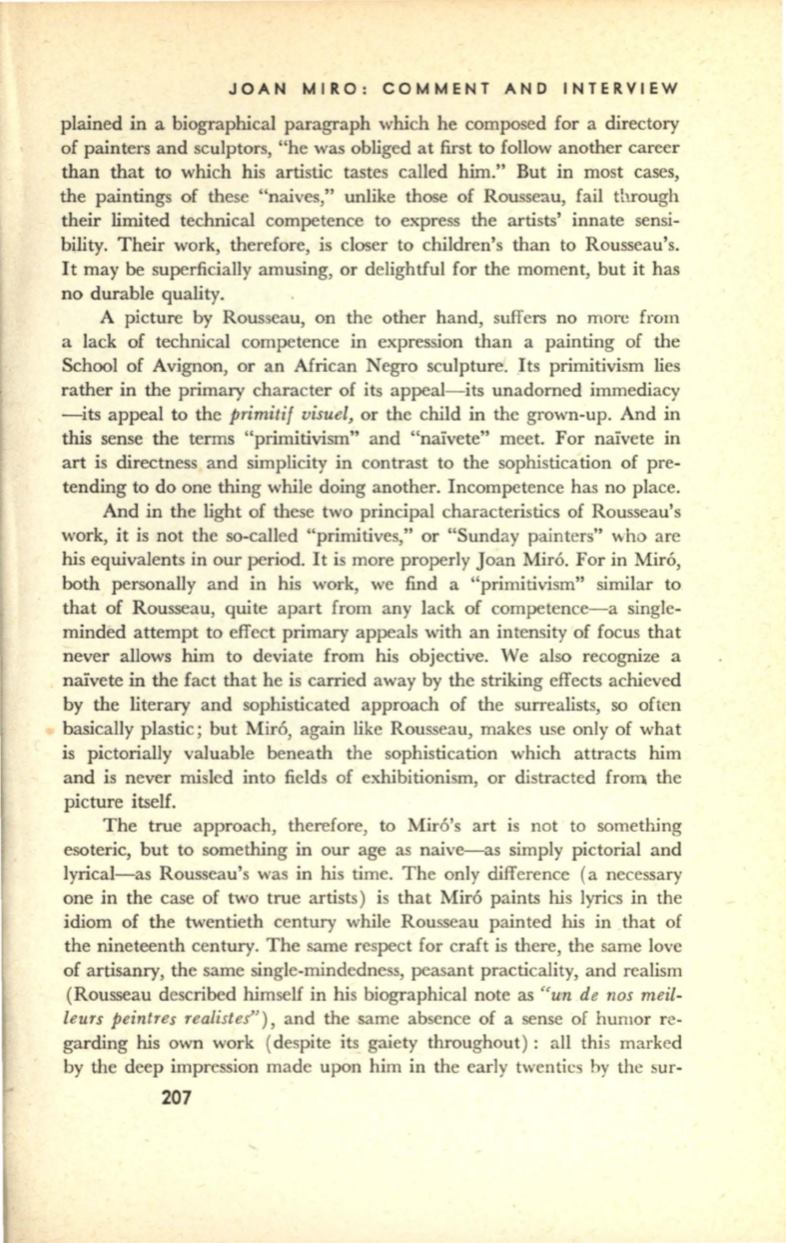
JOAN MIRO: COMMENT AND INTERVIEW
plained in a biographical paragraph which he composed for a directory
of painters and sculptors, "he was obliged at first to follow another career
than that to which his artistic tastes called him." But in most cases,
the paintings of these "naives," unlike those of Rousseau, fail through
their limited technical competence to express the artists' innate sensi–
bility. Their work, therefore, is closer to children's than to Rousseau's.
It may be superficially amusing, or delightful for the moment, but it has
no durable quality.
A picture by Rousseau, on the other hand, suffers no more from
a lack of technical competence in expression than a painting of the
School of Avignon, or an African Negro sculpture. Its primitivism lies
rather in the primary character of its appeal-its unadorned immediacy
-its appeal to the
primitif visuel,
or the child in the grown-up. And in
this sense the terms "primitivism" and "naivete" meet. For naivete in
art is directness and simplicity in contrast to the sophistication of pre–
tending to do one thing while doing another. Incompetence has no place.
And in the light of these two principal characteristics of Rousseau's
work, it is not the so-called "primitives," or "Sunday painters" who are
his equivalents in our period. It is more properly Joan Mir6. For in Mir6,
both personally and
in
his work, we find a "primitivism" similar to
that of Rousseau, quite apart from any lack of competence-a single–
minded attempt to effect primary appeals with an intensity of focus that
never allows him to deviate from his objective. We also recognize a
naivete
in
the fact that he is carried away by the striking effects achieved
by the literary and sophisticated approach of the surrealists, so often
basically plastic; but Mir6, again like Rousseau, makes use only of what
is pictorially valuable beneath the sophistication which attracts him
and is never misled into fields of exhibitionism, or distracted from the
picture itself.
The true approach, therefore, to Mir6's art is not to something
esoteric, but to something in our age as naive-as simply pictorial and
lyrical-as Rousseau's was in his time. The only difference (a necessary
one in the case of two true artists) is that Mir6 paints his lyrics in the
idiom of the twentieth century while Rousseau painted his in that of
the nineteenth century. The same respect for craft is there, the same love
of artisanry, the same single-mindedness, peasant practicality, and realism
(Rousseau described himself in his biographical note as
"wn de nos meil–
leurs peintres realistes"),
and the same absence of a sense of humor re–
garding his own work (despite its gaiety throughout) : all this marked
by the deep impression made upon him in the early twenties by the sur-
207


